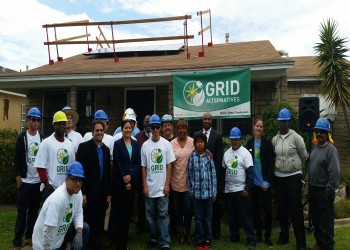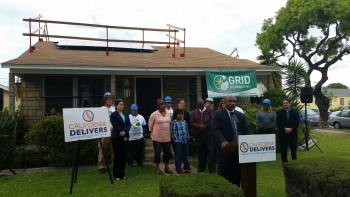On what was a mostly cloudy day in the Willowbrook neighborhood of South Los Angeles, the sun emerged in time for resident Rose Pinkney to celebrate the installation of free solar panels on her rooftop.
In an event held in front of her home on Friday, Pinkney, a self-professed techie whose neighbors often knock on her door for advice, beamed as she shared her excitement about the new installation to her home near McKinkey Avenue and 120th Street.
“This is a way to promote clean energy that is well needed in neighborhoods filled with pollution,” said Pinkney, addressing a small crowd of curious neighbors and a handful of reporters.
The event was organized by California Delivers, a coalition of over 300 businesses, public health professionals and community leaders passionate about keeping the initiatives of AB 32, California’s clean air and climate law, active beyond its 2020 expiration date.
Within AB 32, the cap-and-trade program is forecasted to generate $2.2 billion in funding which will be spent on clean energy by July 2016. This program was also responsible for allocating funds to additional programs, like non-profit GRID Alternatives — which provided the free installation of Pinkney’s solar panels.
Cap-and-trade gains its funding by placing limitations on corporations with the highest greenhouse gas (GHG) emissions. Each year, a strict cap is placed on the amount of GHG’s that corporations can emit. The cap decreases every year and corporations exceeding the limit of GHG emissions are fined, resulting in the production of funds to promote clean energy and minimize pollution throughout the state.
Of those funds, a minimum of 25 percent is designated to benefit communities like Pinkney’s that have been identified by 19 statistical factors in the California Environmental Protection Agency’s CalEnviroScreen 2.0 tool, as economically disadvantaged and hardest hit by pollution.
This year, $75 million were allocated to the state’s Low Income Weatherization Program. This program will fund weatherproofing services including the installation of rooftop solar panels, solar hot water systems, and other energy efficient technologies to over 17,000 homes in neighborhoods similar to Pinkney’s throughout the state.
To install solar panels like the ones on Pinkney’s Willowbrook home, LIWP is working with the non-profit organization GRID Alternatives. The organization is expected to install panels on 1,600 more homes throughout the state–about 200 of which are slated to be on homes in the greater Los Angeles area.
Pinkney, who hopes to also implement the use of solar technology in the community garden just blocks from her home on 120th Street, told Intersections South LA that she believes her solar panels will set a positive example for her neighbors.
“Often, people in certain communities are afraid to take advantage of new technologies,” Pinkney said.
Pinkney said she understands the skepticism. Some have already raised concerns regarding the panels’ durability, who foots the bill for repair costs and whether the system will truly help save money. She said, however, when discussing it with her neighbors she hones in on the positives that solar technology brings.
The energy generated by Pinkney’s two solar panels should cover about 80 percent of her energy bill. Whatever Pinkney doesn’t use of the energy generated by her solar panels will flow to the city’s electrical grid for others to tap into, turning Pinkney’s home into a tiny, local distributor of energy. At that time, she will earn credits that lets her electrical meter to run backwards.
As a result, Pinkney will spend $1,300 less on energy each year — money she intends to place in a retirement fund. Over an expanded 30-year period of time, California Delivers estimates savings of $39,000 for Pinkney — an amount the lively and enthusiastic grandmother gladly welcomed.
“Not only do you reduce your bills, you give back to the community and, in a way, the universe by using clean energy,” said Pinkney, also noting how solar energy might increase her property value.
The installation of solar panels is just one of many projects coming out of the AB 32 initiatives, according to Hector de la Torre, a member of the California Air Resources Board. Other statewide projects include the development of mass transit and cleaner-running vehicles as well as protecting natural water sources from pollution and global warming.
Reverend Reginald Hansome, Pastor at Ascension Lutheran Church and New City Parish, echoed the importance of conservation and green energy in a short speech celebrating the installation.
“We gather here, today, to talk about power,” began Hansome. “Renewable energy and jobs are coming to the community. People are being empowered in an area where usually they may not be.”
As AB 32 funding continues through 2020, the measure’s goal is to back innovative programs that address air pollution, unemployment and energy production.
GRID Alternatives serves as “a triple benefit for the community,” the executive director of GRID Alternatives Greater Los Angeles Michael Kadish said in a press release. To date, the organization has trained 20,000 community members in the energy trade.
Solar and green technology, according to California Delivers, brings both clean, locally produced energy and reduced energy bills. In addition, it brings jobs. The energy field is a consistent area of growth in the job market in California. Since 2010 the trade has grown 86 percent and continues to add jobs at a rate of 20 percent each year.
One GRID Alternatives trainee, Matthew Martinez, 26, grew up in South LA and lives only five minutes away from Pinkney’s home where he helped install the panels. In addition to providing him with a job despite having spent time in and out of jail, Martinez said while working with GRID Alternatives, he feels like he is a part of the community and a member of the what he calls the “renewable energy family”.
Pinkney shared similar sentiments. She told Intersections South LA that two of her family members had received panels through GRID Alternatives before new funding arrived. She said her niece was the one who piqued her interest in determining her eligibility for the program.
“She said, ‘You don’t have solar, Auntie?’” Pinkney recounted. After a recent job change which involved a pay cut, Pinkney found herself in the right bracket for the program.
“Now, we all have solar,” Pinkney said, motioning toward her roof and the technology she hopes she’ll continue to see spring up throughout the neighborhood.
At the end of the event, a handful of neighbors approached Pinkney about her new solar panels. With a luminous smile, she guided them to a GRID Alternatives representative who began filling out applications on the spot.

















Speak Your Mind